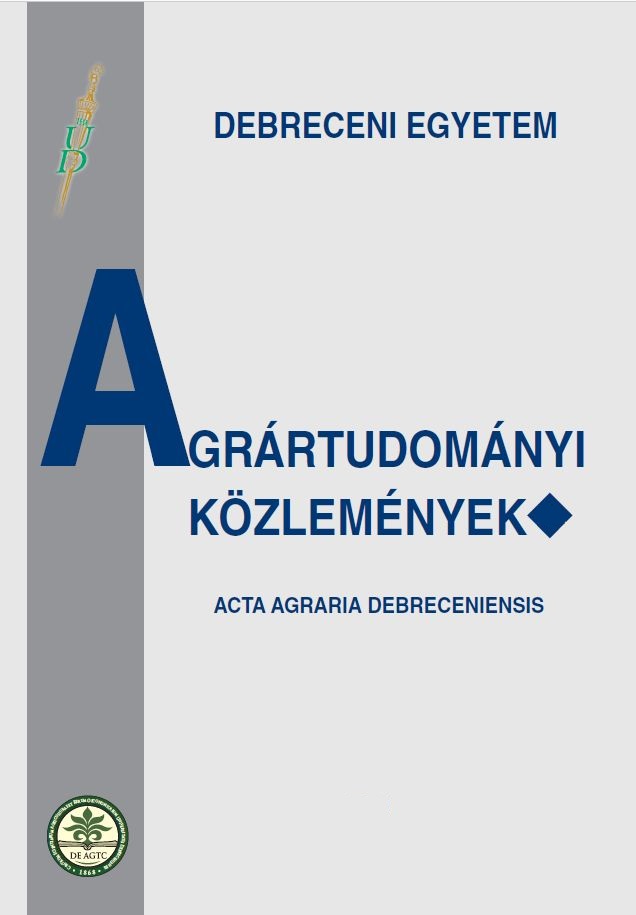The effect of bentonite on the quantity change of soil microorganisms, the CO2-production and the activity of saccharase enzyme
Author
View
Keywords
How To Cite
Abstract
We examined the impact of bentonite – the perspective improving material of sandy soils – and treatments of livestock manure composted with bentonite on sandy soils, within the framework of a small-plot experiment.
The adjustment of the experiment was made on the Experiment Site of the Nyíregyháza Research Centre of the University of Debrecen, Centre of Agricultural Sciences (UD CAS). We collected soil samples from parcels treated with increasing bentonite doses (5, 10, 15, 20 t/ha) on the one hand, and from the parcels treated with livestock manure composted with increasing doses of bentonite, on the other.
We performed laboratory research in the soil microbiology laboratory of the Soil Science Faculty of UD CAS DAS, during which we determined the total number of bacteria, the quantity of microscopic fungi, the number of cellulose-decomposing bacteria, the CO2-production of the soil and the activity of saccharase enzyme.
During the evaluation of the examinations, we made a statistical analysis using SPSS 9.0. We determined the average of measurements, the standard deviation of controls, the standard deviation, the significance value and we also performed a correlation analysis.
Concerning the impacts of bentonite treatment and the treatment of livestock manure composted with bentonite on the examined microbiological features of sandy soil, we can summarize the following:
• Our results prove that the microbiologic activity of the soil has increased owing to the impact of bentonite treatments regarding total number of bacteria and the quantity of microscopic fungi. ”Pure bentonite” treatments – although not significantly in every case – increased these values, but larger doses decreased them. The treatments of livestock manure composted with bentonite resulted in a larger increase regarding both parameters.
• The number of cellulose-decomposing bacteria was increased by the low doses of both series, and was decreased by the higher doses. Higher bentonite doses decreased it in a higher – significant – degree than those of treatments of livestock manure composted with bentonite, whose low dose caused salient number of bacteria.
• Regarding the carbon-dioxide formation, we have experienced an increase even in the case of low dose treatments (nevertheless, the increase did not prove to be significant), but – similarly to the quantitative changes in the number of cellulose-decomposing bacteria – the large doses of both series of treatment decreased the CO2-production of the soil.
• Bentonite also increased the activity of saccharase enzyme significantly. We learned that”pure bentonite” treatments increased the activity of the enzyme to a higher degree than composted treatments. Moreover, it can be stated that the treatments of larger doses of both bentonite and livestock manure composted with bentonite have decreased the enzyme activity – not significantly, though.
• Based on the correlation analysis, it can be stated that as an impact of the treatments, the microbiological activity of the soil has also increased with the increase of the number of soil microbes, as in both treatment series we have experienced a tight positive correlation (r=0.81-0.82) between the change of total number of bacteria and the CO2-production of soil. In both treatments, there was a medium correlation between the total number of fungi and soil respiration (r=0.63-0.63). Furthermore, it can be stated that the usage of organic manure had a positive effect on the activity of cellulose-decomposing bacteria, as in this treatment series there was a positive correlation (r=0.65) between this physiological group and CO2-production. Both treatments prosperously impacted the activity of saccharase enzyme, because there was a medium correlation (r=0.62-0.64) between the activity of the enzyme and soil respiration.

 https://doi.org/10.34101/actaagrar/26/3088
https://doi.org/10.34101/actaagrar/26/3088